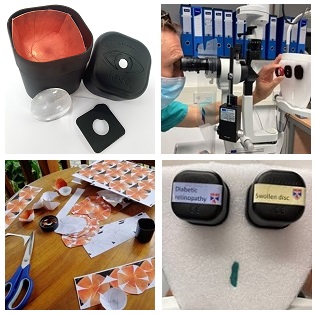SIMulation Eye New
Why Simulation?
Simulation based training is increasingly being integrated into medical teaching. This process has been accelerated by the COVID-19 pandemic. The advantages of being able to provide consistent progressive training and assess competency in a safe, controlled and flexible environment as well as reduce face-to-face contact are of clear benefit to patients, trainees and trainers alike.
Most simulation tools are however expensive and impractically so for those training in low- and middle-income settings where the need is greatest to deal with the emerging epidemics of blindness from diabetes and premature birth.
We have developed highly realistic SIMulation tools to hone anterior segment, fundal reflex, direct ophthalmoscopy and otoscopy examination. They rapidly build confidence and the hands-on coordination needed to examine eyes and ears.
Simulation eye
Simulation eyes (SIM eyes) can be used to teaching examination skills for direct ophthalmoscopy, binocular indirect ophthalmoscopy and slit-lamp examination. The simulation eyes can also be used to teaching retinal laser skills.
Key features
- The optics is based on a ‘reduced’ model eye.
- A simple and durable simulation eye for teaching and training, for use with the Arclight devices.
- The three-dimensional fundi are created from traditional wide-field flat images.
- Printed with a domestic high-resolution colour printer on a matte photographic paper and can be mass produced.
- Despite being inexpensive, creates high resolution anatomically accurate ora to ora fundi.
- Easily swappable images.

Resources for SIM eyes
- Direct ophthalmoscopy
- Indirect ophthalmoscopy and slit-lamp
- Retinal laser
Pathologies simulated in the SIM eyes
- Optic nerve pathologies:
- Swollen optic nerve
- Cupped optic nerve head
- Optic nerve atrophy
- Macular and posterior pole pathologies
- Age-related macular degeneration
- Diabetic retinopathy
- Diabetic maculopathy
- Retinal vein occlusion
- Retinal infections
- Peripheral retinal disease
- Retinopathy of prematurity
- Retinal detachment
- Retinal breaks and degeneration
- Retinal dystrophies






